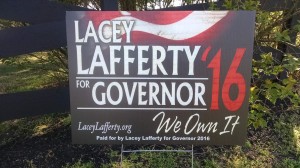Tonight I finally finished my political widget for 2020 with the races I intend to highlight. Nationally I have the Presidential race, of course, with those who will be on the ballot in Delaware. [I have spotted the Green Party this one; however, I may have to change Howie Hawkins to a write-in if they indeed don’t make the ballot – they were right on the bubble last I saw.)
The biggest amount of work I had was the Senate race, although the Governor’s race was a surprisingly close second. In both instances, not everyone has a website as some simply get by with a social media page – and are lucky to get 1% of the vote.
Indeed, we will have the largest GOP primary field for governor in the state’s relatively brief history of primaries – the most I found in my limited research was three, and this time we have a half-dozen thanks to Scott Walker’s late entry. He is one of two of those perennial candidates, the type I’m familiar with from Maryland thanks to their comparatively lax threshold for getting on a party ballot. It’s not quite “alive and breathing” but it’s not that far off, either. Walker and David Graham are serial candidates, although neither has always run as a Republican.
With businessman Neil Shea formally withdrawing on Thursday, the two outsiders are attorney Julianne Murray and business owner David Bosco, who was actually the first one of the remaining six to formally file after Shea got the ball rolling in late May. Add in the two sitting State Senators able to run from cover this time around (Colin Bonini and Bryant Richardson) and it’s a race where any of them would kill for 40% because that is likely sufficient. (In six-way Democrat primaries four years ago, Lisa Blunt Rochester won with 43% to 25% for her nearest competitor and Bethany Hall-Long prevailed with 29% to 22% for second place. So first to 40 almost definitely wins and 35 may be enough.) Right now Bonini would probably be the favorite simply based on name ID but he’s also lost statewide twice so one of the new faces may be a surprise winner.
By the same token, the Democrat primary is also worth watching because John Carney has a primary challenger from his left (just like U.S. Senator Chris Coons does.) There’s little doubt Carney will win, but a showing of 25-30% from the challenger would mean Carney’s support would be soft among progressives or could be construed as a protest vote against his draconian rule during the pandemic. I think the latter would be more true if the Democrat turnout was much lighter than the GOP’s or Carney’s race was significantly undervoted compared to the other statewide races. (This also applies to the Coons race.)
The U.S. Senate and House races are rather “meh” compared to the battle for governor. There are only two contenders on the Republican side for both House and Senate, and they both pit multi-time losers against fresh faces which have their own baggage. It’s actually possible that both members of Delaware’s Congressional delegation would have jail time on their resumes, although both claim to have been humbled by the experience. Both these races are older men against younger candidates roughly half their age – one a photogenic woman and the other a Log Cabin Republican.
Aside from that, the statewide ballot will be rather light in September. Primary voters will see a race for Insurance Commissioner on the Democrat side, but that’s it. On a local level, there is only one race for a Delaware General Assembly seat from Sussex County and that’s not decided until November. Out of ten possible contests, only one will be elected by other than acclamation.
Now that my field is pretty much locked in, my weekend project is to put the final bow on this session’s monoblogue Accountability Project – Delaware edition and begin working on a dossier series similar to those I’ve done in previous years. For those new to the website, the idea for the dossiers is to take topics of my choosing that I deem most important and take a deep dive into the candidate’s stance on them. (This includes asking them directly.) Each topic is assigned a point value and each candidate is given points based on how closely they fit my ideal, with the winner getting my endorsement. (They don’t get my primary vote because I’m still in the Constitution Party.)
To begin the series, I’m going to lay out one ground rule: the first round through the topics will focus solely on the GOP candidates. I don’t have to worry about the IPOD or Libertarians until after the primary and the Democrats won’t score well with me anyway, so there’s no need for me to score Carney vs. Williams or Coons vs. Scarane. Doesn’t matter which of them win because they’re Lenin to me.
Here are the proposed topics for the 2020 races. If you were here in 2016, these will sound familiar for the federal races:
Federal races: Education, Second Amendment, Energy, Social Issues, Trade and Job Creation, Taxation, Immigration, Foreign Policy, Entitlements, Role of Government, and Intangibles. (Intangibles is sort of a catch-all of other stuff.)
Governor: Agriculture/Environment, Transportation, Social Issues, Law Enforcement/Judicial, Education, Second Amendment, Job Creation, Taxation, Role of Government, Intangibles. Notice the order shifts around somewhat at the state level.
Once I get the mAP up next week, I’ll begin posting my dossier series. It’s going to be a busy couple months here at monoblogue.



